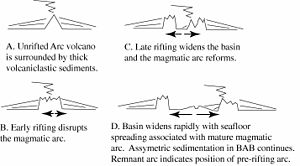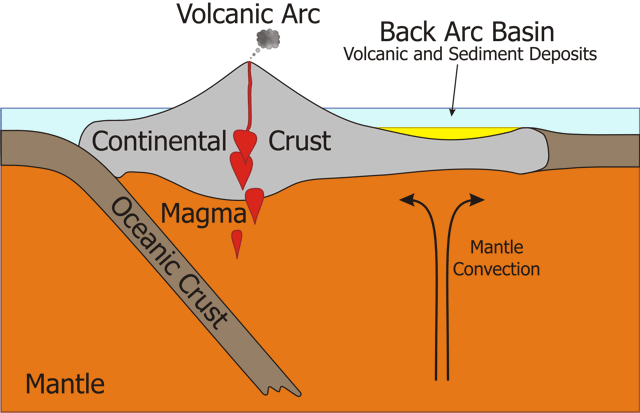Back-arc basin
Backarc basin (English back- arc basin ) and forearc basin (English fore-arc basin or outter arc) are basins or, if particularly well developed, even the lake basin, which at the subduction of an oceanic plate under another oceanic plate or continental plate arise and strongly pronounced differently occur. English prefixes back (back) and fore (before ) in this case relate to the situation in relation to marked by volcanism island arc located between these basins. In contrast to the actual island arc to be there on the islands, which conclude the forearc basin, no volcanism.
Where the subducted plate dives beneath the overlying plate, there is a deep groove. Between the deep-water channel and the island arc of the forearc region, ie before the magmatic arc region of the island, this area is therefore also called magmatic gap. Here is caused by the delivered and ansedimentierte of the subducting plate material is a accretionary prism, but sometimes a survey forms instead of the wedge shape (which sometimes reaches the sea surface, such as in Crete and Barbados), and a pool ( see illustration).
On the other side of the island arc, so to speak, behind the magmatic range, the backarc is area, as this may lead to expansion of the continental plates and can sometimes whole oceans by magmatic embossed spreading zones arise. Backarc basin formed preferentially at island arcs, subduction zones in their relatively old, ie heavy oceanic crust is subducted. The subducted oceanic plate dips here at a relatively steep angle from under the island arc. This creates tensile forces at the plate, under the dives, the oceanic plate (a process eng. Slab roll-back called ). So it can replace half (hence engl. Back arc) of the magmatic arc ( island arc ) in the formation of fracture zones and trenches ( faulting ) may occur, in which forms new oceanic crust. The fracture zones formed within the magmatic arc can develop into relatively small oceanic basins, which consist of relatively young oceanic crust. Another model is based on a tearing of subducted oceanic crust, followed by a coat of upwelling, resulting in extensional tectonic movements in the backarc area, this model will Engl. called ( in German about disk demolition ) as so-called slab break -off.
Examples of relatively large backarc basin are the Japanese basin between the Asian mainland and Japan, the South China Sea and the Sulu Sea and the Celebes Sea.
Examples of active backarc spreading zones are the Mariana Trough in the backarc region of the Mariana arc in the eastern Philippine Sea and the Havre Trough ( Lau Basin) between the Kermadec - Tonga Ridge and the Colville - Lau Ridge northeast of New Zealand.










